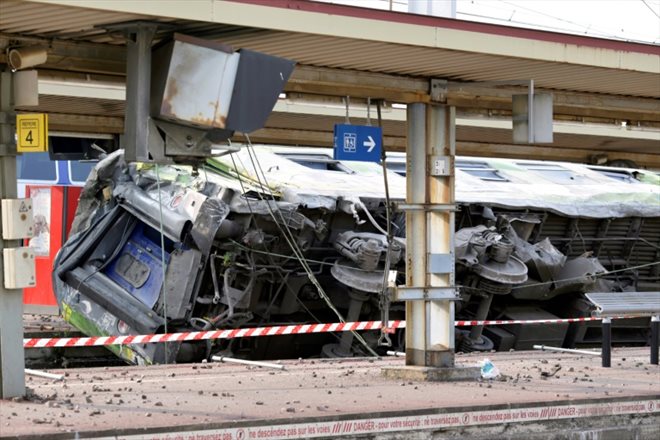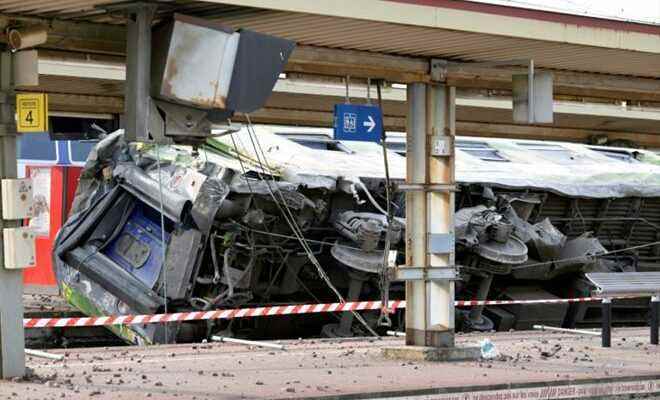The derailment of the Paris-Limoges Intercités train at Brétigny-sur-Orge station on July 12, 2013 (AFP/Archives/-)
In a firm indictment, the Evry prosecutor’s office on Wednesday requested the maximum penalty of 450,000 euros against the SNCF, “a company in denial”, which it considers guilty of injuries and involuntary homicides during the Brétigny rail disaster of 2013 .
For prosecutor Rodolphe Juy-Birmann, the SNCF is guilty of having “created the context at the origin of the accident”, which left seven dead and hundreds injured, by “a failure in the maintenance chain” .
He is criticized for his “failing attitude”, “to have sloppy and not to have wanted to spend time on maintenance operations”, explains the prosecutor.
With this disaster and the seven-year investigation that followed, “it’s a whole conception of public service that has collapsed,” he says.
Rodolphe Juy-Birmann, on the other hand, requested the release of the two other defendants: the SNCF Réseau (track manager, ex Réseau Ferré de France) and the former railway executive, Laurent Waton, who was accused of having chosen to carry out the last round of surveillance, unaccompanied and therefore with less vigilance.
For Laurent Waton, the prosecutor noted “simple, ordinary” or even “disciplinary” faults but not “characterized fault” criminally.
For SNCF Réseau, he was “forced to request release”, because he lacked either evidence or evidence of RFF’s responsibility to request his conviction. These requisitions for release disappointed the side of the civil parties.
– “Trivializing the emergency” –
Throughout the trial, the SNCF disputed the alleged faults, attributing the accident to an undetectable defect in the steel of the switchgear, a thesis supported by “pseudo experts”, in the words of the magistrate, during a frantic battle of expertise that lasted several weeks.

Trial of the Brétigny rail disaster in 2013 (AFP / Sylvie HUSSON)
If the defect was undetectable, the accident was unpredictable, which would clear the SNCF and confine the railway disaster to “a simple accident”, tackles the prosecutor.
At the SNCF, “we put this anecdotal event in the aisle of bad memories”, he is still indignant, castigating the broadcast of a video, three days before the trial, in which the management of the company called its railway workers “on reserve” and for which he asked for an additional penalty.
Nine years after the events, the SNCF is still “a company in denial” which does not assume to have “trivialized the emergency”, to the detriment of the safety of users.
The SNCF is judged because it is the penal heiress of the SNCF Infra, in charge of the maintenance of the tracks at the time of the facts.
The penalty required against him amounts to a fine of 450,000 euros, due to the legal recidivism that the prosecutor asked the court to retain after a fatal accident in Troyes judged in 2013.
“A fine, whatever the amount, is meaningless for the victims: no penalty will bring anyone back to life,” he admits. However, he hopes that such a sentence, if pronounced, will bring “two satisfactions” to the more than 200 civil parties.
– “The opprobrium and discredit” –
First, that of having “been heard and recognized in your victim status”. And above all, “the conviction will bring shame and discredit” on the public company, he predicts.
Regarding the SNCF, the prosecutor accuses him of twelve faults with an “original fault of disorganization” which does not “involve the railway workers” but brings to light “the slow deterioration of their working conditions, impacted by profitability objectives”.

The derailment of the Paris-Limoges Intercités train at Brétigny-sur-Orge station on July 12, 2013 (AFP/Archives/Kenzo TRIBOUILLARD)
Among these faults, a “traceability defect” in Brétigny-sur-Orge: “the one who makes the observations” on the switchgear “is not the one who signs, the one who takes the dimensions is not the one who written on the sheet …”, illustrates the prosecutor.
This “lack of traceability did not make it possible to maintain a sufficient level of alert” on a device known, however, for its “recurring geometry defects”.
This complex device, called double junction crossing, should have been changed in advance. Permanently reduced train speed.
The prosecutor pointed to the usual “delay in maintenance”, with operations postponed, “because other emergencies take precedence”.
And this “obvious negligence” in the follow-up of a 10 mm crack detected in 2008 on a crossing heart of the device: this heart “has never been examined”, he says.
The pleadings in favor of SNCF Réseau and Laurent Waton begin on Thursday, followed by those of SNCF on Friday.
© 2022 AFP
Did you like this article ? Share it with your friends with the buttons below.




